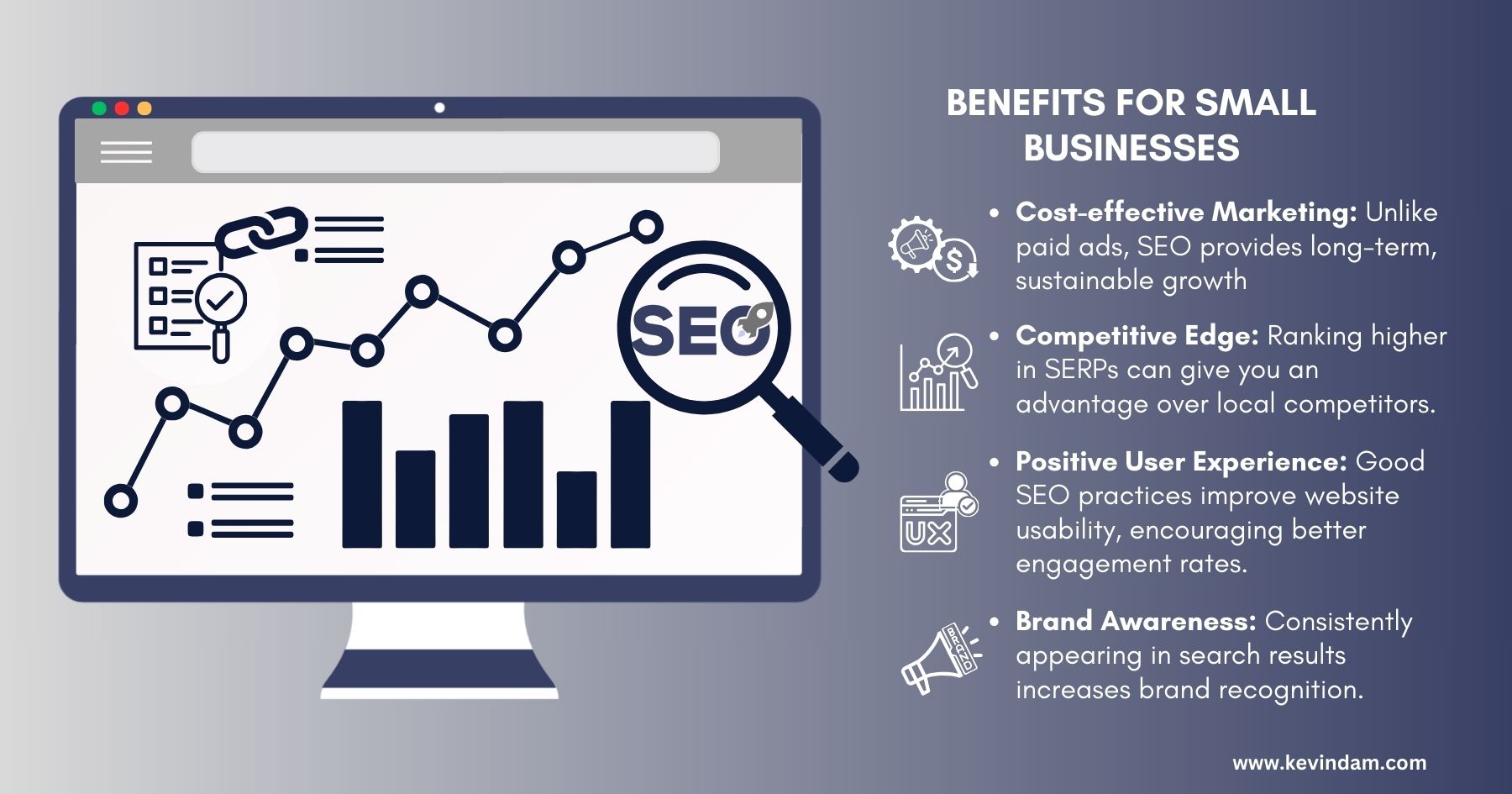
Last Updated July 22, 2024
Small Business SEO Strategy: The Ultimate Guide to Boosting Online Presence
With so much competition online, small businesses often struggle to stand out. Understanding SEO is a helpful strategy for any small business aiming to thrive and be seen online.
From understanding your audience and setting clear objectives that align with your business goals to leveraging tools like Google Analytics and Search Console, this guide offers actionable insights to enhance your digital profile and gain a competitive edge. Discover how quality content, optimised performance, and strategic linking can elevate your digital profile and secure your place in the competitive market.
Importance of SEO for Small Businesses

Search Engine Optimization (SEO) is the practice of optimising your website to rank higher in search engine results, thus increasing the quantity and quality of organic traffic.
Why it Matters
For small business owners, implementing an effective SEO strategy is crucial because of these reasons:
- It increases the visibility of your business in search engines.
- It can lead to more targeted traffic, which often translates to increased sales.
- SEO helps build credibility and trust with potential customers by ensuring your business appears prominently in relevant searches.
Benefits of SEO for Small Businesses:
- Cost-effective Marketing: Unlike paid ads, SEO provides a long-term, sustainable growth channel.
- Competitive Edge: Ranking higher in search results can give you an advantage over local competitors.
- Positive User Experience: Good SEO practices improve website usability, encouraging better engagement rates.
- Brand Awareness: Consistently appearing in search results increases brand recognition.
Defining your SEO strategy
A successful SEO strategy for small businesses isn’t a one-size-fits-all solution. It should be planned to align with your specific business goals, industry, and resources. It considers not only prevalent best practices in SEO but also leverages the unique qualities of your business to compete online effectively. Here’s how you can tailor your SEO strategy for impactful results.
Identify Your Target Audience
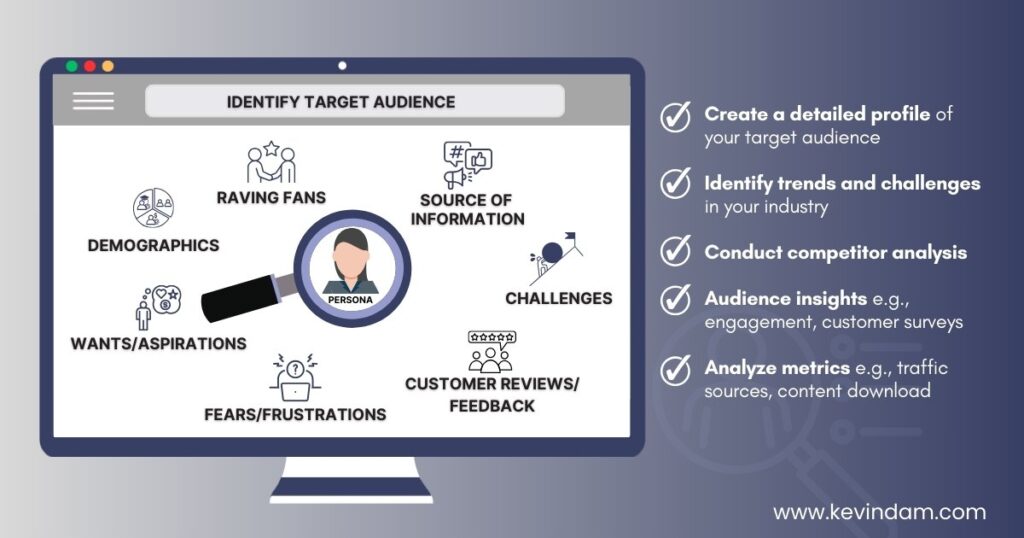
Identifying your target audience is the foundation of any effective marketing strategy, including SEO.
Here’s why it matters:
- It helps you to craft content that resonates with your audience’s interests and solves their problems
- You can optimise for search terms and questions that real users are entering into a search engine
- You can enhance site navigation and user experience to better serve your customer’s needs.
In identifying your target audience:
- You can start with the best customers you already have. Who are the people who keep coming back or raving about your business? Look for similar patterns (age, profession, interests).
- Think of your product or service.
– What problem does it solve?
– Who benefits the most from solving that problem? - Look into the details.
– Demographics: Age range, location, and income level of your ideal customer.
– Challenges: Problems they are trying to solve or needs they wish to satisfy.
– What are their interests, hobbies, values and lifestyle?
– What are their interests, hobbies, values and lifestyle?
– Where do they get information online (social media, websites)? - Listen to your target audience.
– Look at customer reviews and feedback.
– Engage with them on social media to understand their needs.
Understanding your target audience can guide you in creating compelling and relevant content that addresses their pain points and provides solutions. By aligning your SEO efforts with the needs and challenges of your buyer personas, you can elevate the effectiveness of your small business SEO strategy in reaching the right audience.
Setting Realistic SEO Goals for Your Business Growth
Setting specific goals keeps you focused on what matters most, and seeing progress towards achievable goals keeps you motivated and on track.
For instance, if you want to improve keyword rankings, track how your targeted keywords move up in SERPs or if the goal is to enhance brand visibility, work on appearing in more search queries related to your niche.
Connect SEO to those goals. How will improved SEO help you reach those goals? You should also consider your resources, such as time, budget, and team size. And focus on achievable targets. Don’t aim to jump to the top of search results overnight. Start with smaller, attainable goals and build from there.
Setting quantifiable objectives lets you refine your strategy based on what’s working.
Setting up your Google Analytics and Google Search Console
Introduction to Google Analytics

Google Analytics is an essential tool for small business owners to monitor and improve their SEO strategy. It’s an invaluable resource for SEO as it allows businesses to analyze in-depth details about their website visitors.
Here’s what you need to know about this tool:
- Free Tool: Available at no cost for anyone with a Google account.
- Integration: It can be easily integrated with your website by adding a tracking code to your pages.
- User-Friendly Dashboards: Provides customisable dashboards to view various metrics.
- Reports: Offers a range of reports highlighting different aspects of your website’s performance.
Key metrics in Google Analytics
For newcomers to SEO, comprehending key metrics in Google Analytics is important as it gives you insights into the effectiveness of your SEO strategy:
- Sessions: Total number of visits to your site, including repeat visits by the same user.
- Users: The number of unique visitors to your site.
- Pageviews: The number of times any page on your site is viewed.
- Bounce Rate: The percentage of single-page visits with no further interaction on your website.
- Average Session Duration: The average length of time spent on your site.
- Conversion Rate: The percentage of visitors who take a desired action, like making a purchase or signing up.
Analysing website traffic and user behaviour
Understanding who visits your website and what they do when they arrive is key to refining your SEO. Google Analytics helps you break this down:
- Traffic Sources: Discover where your visitors come from – organic, direct, referral, or social media.
- Content Performance: Identify which pages are the most popular and which struggles to keep visitors engaged.
- User Flow: Understand the path users typically take through your website.
- Device Usage: See whether users are visiting from a desktop, mobile, or tablet.
Optimising website content based on Google Analytics data
Google Analytics provides actionable data that can be used to optimise your website content:
- Identify Top Content: Focus on the pages that generate the most traffic and engagement and produce similar content.
- Improve Underperforming Pages: Revise or update pages with high bounce rates or low traffic.
- Adjust based on User Flow: Enhance navigation to commonly visited pages to improve user experience.
- Tailor for Devices: Ensure your website is mobile-friendly if a significant portion of traffic comes from mobile users.
By regularly reviewing your Google Analytics data and adapting your content accordingly, you can continually refine your SEO strategy for better performance and higher user satisfaction.
Introduction to Google Search Console
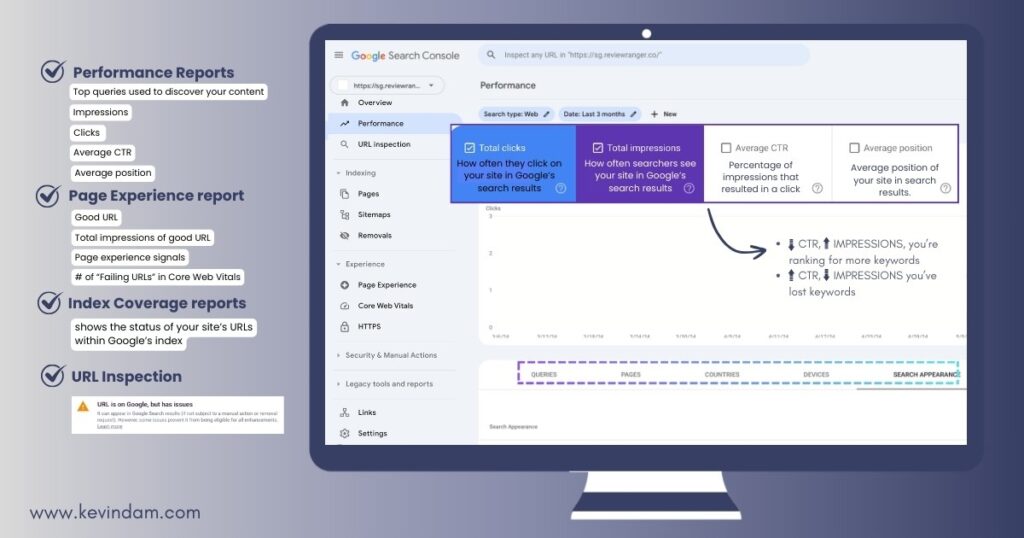
Google Search Console provides a range of features to monitor and optimise your search presence, track your site’s performance, and resolve issues that could be affecting your rankings in search results.
- Free Web Service: Google Search Console is a free service offered by Google. It’s designed to help website owners monitor and maintain their site’s presence in Google search results.
- Understand Performance: See how your site appears in search results and which queries show your site, as well as how often people click through for those queries.
- Get Alerts: Receive notifications about issues on your site that can affect your rankings, such as crawl errors or security issues.
- Troubleshoot Issues: Use it to troubleshoot and resolve common technical SEO problems such as broken links or indexing problems.
Submitting and managing XML sitemaps
- Communicate with Google: Sitemaps are a way to tell Google about the pages on your website that might not otherwise be discovered.
- Update Information: When you submit your XML sitemap, you ensure that Google has the latest information about your web pages.
- Easy to Manage: You can create and submit sitemaps through the Search Console, and once added, you can easily monitor the sitemap’s status and the number of indexed pages.
- Prioritise Content: Use the sitemap to inform Google which pages you consider important in your site.
Utilising search analytics to improve search engine visibility
- Performance Data: Get in-depth data on how your site performs in Google, such as click-through rates (CTR), positions, and impressions.
- Query Insights: Understand which keywords and queries are driving traffic to your site and use those insights to guide content creation and optimisation.
- Geographical Success: Monitor which countries your traffic is coming from, guiding potential localisation or translation efforts.
- Device Breakdown: Find out if your users are coming from desktop, mobile, or tablet devices and optimise accordingly.
By leveraging Google Search Console, small businesses can significantly boost their SEO strategy and ensure that their websites are well-positioned to capture organic traffic. From managing sitemaps to resolving technical issues and analyzing search analytics, this tool provides valuable data and actionable insights that can transform your online presence.
Conducting Keyword Research for Small Businesses
For small businesses venturing into SEO, keyword research is the process of finding words and phrases that potential customers use when searching for products or services like yours. Here’s how to get started:
- Use Keyword Tools: Leverage tools like Google Keyword Planner or SEMrush to discover relevant keywords.
- Analyse Search Volume: Look for keywords with enough search volume to drive traffic but not so competitive that ranking is unlikely.
- Consider Long-tail keywords: They might have lower search volumes, but they also have less competition, which can be a goldmine for small businesses.
- Study Competitors: See what keywords competitors are ranking for and identify opportunities for your business.
- Search Intent: Understand the purpose behind their searches – are they looking to buy, learn, or locate something?
- Local Keywords: Use geographic modifiers relevant to your location, such as:
- City or town names (e.g., “dentist in [your area]”).
- Neighbourhoods (e.g., “coffee shop in {near your area]”).
- Landmarks (e.g., “bakery near the [known landmark]”).
- Think Like a Customer: Consider the search terms that potential customers might use when looking for solutions that your business provides.
Optimising Website Content with Target Keywords
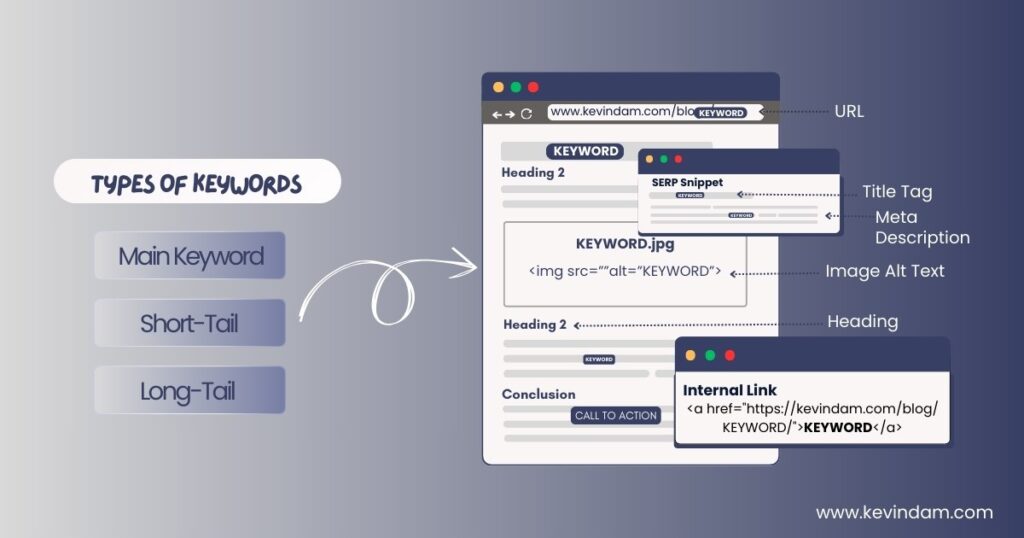
Once you’ve identified your target keywords, integrating them into your website’s content is crucial. Keep the following points in mind:
- Title Tags and Meta Descriptions: Use keywords in title tags and meta descriptions to improve click-through rates from search results.
- Headers and Body Text: Incorporate keywords naturally throughout your headers and the body of your content to signal relevance to search engines.
- Image Alt Text: Include target keywords in image alt attributes to improve image search visibility and accessibility.
- URL Structure: Short and descriptive URLs with keywords can aid in search engine understanding and user perception of the content on the page.
Crafting High-Quality Content
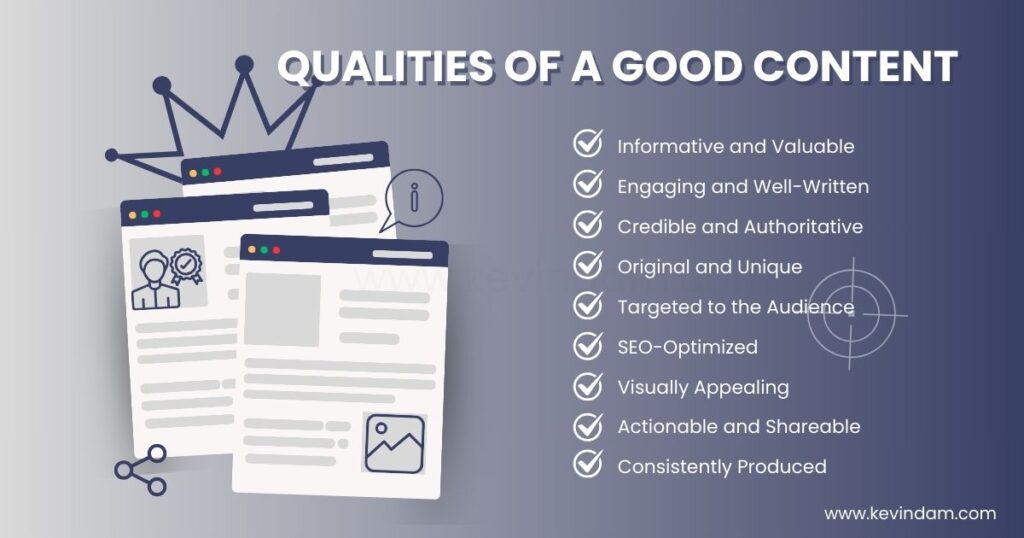
Quality content is a cornerstone of effective SEO and is instrumental in establishing a small business’s digital footprint. A tailored approach to content creation begins with recognising and highlighting your business’s unique selling points and expertise.
- Identify Your Unique Selling Points: Determine what sets your business apart from the competition and emphasise these elements in your content.
- Demonstrate Your Expertise: Sharing valuable insights and experiences positions your business as an industry authority, encouraging trust and credibility.
- Engage Your Audience: High-quality content should engage the reader, providing solutions to their problems and answers to their questions.
By adhering to these guidelines, small businesses can not only improve their content strategy but also amplify their SEO endeavours, leading to greater online visibility and success.
Importance of Quality Content for SEO
Quality content tends to attract more visitors, generate backlinks, and encourage engagement—all critical factors for a small business aiming to improve its search engine rankings.
Here are some reasons why quality content matters:
- Increases Visibility: Well-crafted content can improve your website’s visibility on search engines, which translates to more organic traffic.
- Boosts Engagement: Engaging, informative content prompts visitors to spend more time on your site, reducing bounce rates and signalling to search engines that your site is valuable.
- Generates Backlinks: Quality content is more likely to be shared and linked to by other sites, which can significantly enhance your domain authority and rankings.
- Aligns with Search Intent: Content that aligns with the search intent of users is favoured by search engines, making it critical to understand and meet the needs of your audience.
Optimising Website Speed and Performance
Fast website performance is critical to ensuring a positive user experience. Search engines, like Google, also take load times into account when determining rankings, making website speed a key factor in SEO.
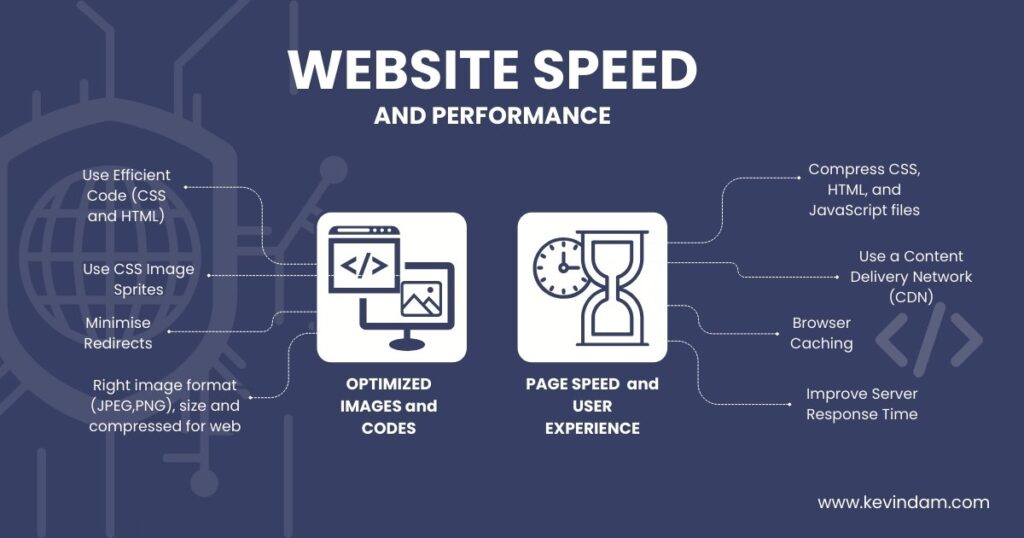
Importance of Page Load Time for SEO
- User Experience: A fast-loading website provides a better user experience. Users are less likely to become frustrated and leave, reducing bounce rates.
- Search Engine Rankings: Search engines prefer to rank websites that load quickly, as they aim to provide the best possible results for users.
- Mobile Optimization: With the increasing use of mobile devices for web browsing, fast load times are even more crucial due to typically slower mobile data speeds.
- Conversion Rates: Websites that load quickly see higher conversion rates, as visitors are less likely to abandon a site that offers a seamless browsing experience.
Techniques for Improving Website Speed and User Experience
- Enable Compression: Use tools like Gzip to reduce the size of your CSS, HTML, and JavaScript files.
- Minimise Code: Remove unnecessary characters, spaces, and comments from code to increase efficiency.
- Leverage Browser Caching: Set up caching to allow users’ browsers to store parts of your site and load them quickly on repeat visits.
- Improve Server Response Time: Look for bottlenecks like slow database queries or inadequate hosting and address them.
- Use a Content Delivery Network (CDN): Distribute your content across multiple servers worldwide to ensure faster delivery to users regardless of location.
Optimising Website Images and Code
- Optimise Images: Ensure images are no larger than they need to be, are in the right file format (JPEG for photos, PNG for graphics), and are compressed for the web.
- CSS Sprites: Combine multiple images into one larger image and use CSS to display only parts of it where necessary to reduce HTTP requests.
- Use Efficient Code: Utilize CSS3 and HTML5 where appropriate, as they provide many features that can make heavy JavaScript unnecessary.
- Minimise Redirects: Each redirect triggers an additional HTTP request, increasing load time, so keep them to a minimum.
By diligently applying the outlined strategies, small business owners can significantly enhance their website’s speed and performance, leading to better SEO outcomes and cultivating a more enjoyable experience for their visitors.
Building an Effective Linking Strategy
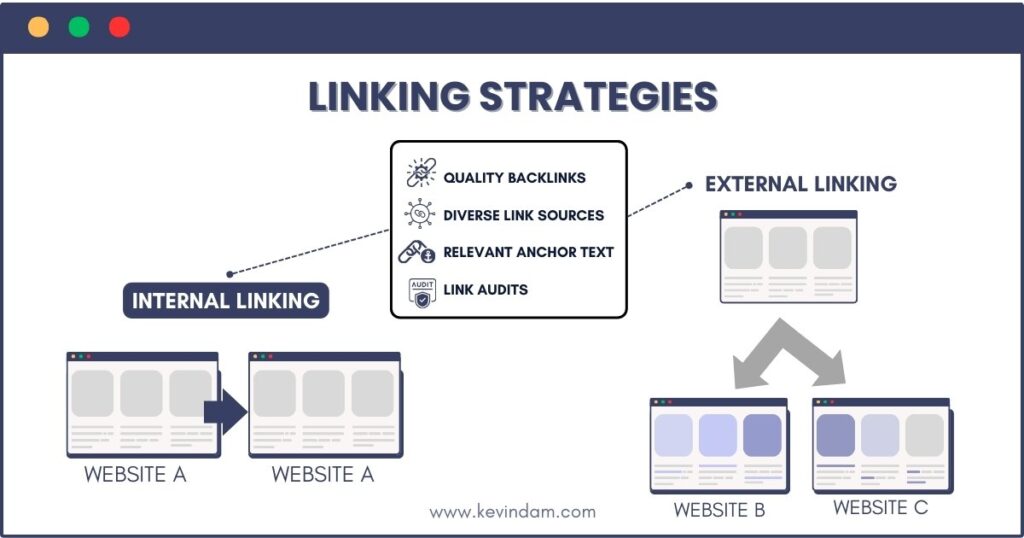
Smart linking boosts your site’s credibility, akin to how a glowing professional recommendation can strengthen a resume. Here’s how you can construct an effective linking strategy:
- Quality over Quantity: Focus on securing backlinks from reputable websites within your industry. These robust endorsements tell search engines your site is a trusted resource.
- Diverse Sources: Aim for a mix of backlinks from various domains to showcase a broad spectrum of support.
- Relevant Anchor Text: Use descriptive and relevant keywords in the anchor text to provide context to search engines.
- Regular Audits: Check your backlink profile routinely for broken links using tools like Google Search Console.
- Internal Linking: Strategically link your pages internally to distribute ‘link juice’ and aid users in navigating your site.
- Avoid Common Pitfalls: Keep an eye out for and resolve duplicate content, technical issues, and loading time delays to maintain link integrity.
Refer to the following table for a quick strategy checklist:
| Strategy Component | Purpose | Tools/Methods |
| Quality Backlinks | Establish credibility | Outreach, Guest Blogging |
| Diverse Link Sources | Enhance ranking potential | Industry forums, Partnerships |
| Relevant Anchor Text | Contextualize links | Keyword-rich anchor text |
| Link Audits | Identify and fix broken links | Google Search Console |
| Internal Links | Improve site navigation | Strategic content linking |
| Avoid Technical Issues | Enhance user experience | SEO audit tools, PageSpeed Insights |
Adhering to these strategies will not only refine user experience but also elevate SEO performance, driving organic traffic to your small business website.
Adjusting SEO Strategy for Better Results
- Regularly check Google Analytics to track your organic traffic trends and understand user behaviour.
- Use Google Search Console to monitor and fix broken links, which can impact user experience and search rankings.
- Investigate PageSpeed Insights for your website to enhance load time and fulfill Core Web Vitals for a better user experience.
- Perform periodic SEO audits to identify technical SEO issues.
- Update internal links to improve the structure and link juice distribution throughout your site.
- Revise external links to ensure you’re connected to authoritative and relevant sources.
- Focus on optimizing target keywords based on search engine trends and user search intent.
- Address duplicate content issues to avoid search engine penalties.
- Mobile Usability is crucial; ensure your site has a responsive design for various devices.
| Area for Revision | SEO Tool or Strategy to Utilize |
| Page Load Time | Google PageSpeed Insights |
| User Experience | Core Web Vitals, SEO Audits |
| Traffic Analysis | Google Analytics |
| Website Errors | Google Search Console |
| Content Relevance | Target Keywords Analysis |
Conclusion
Successful SEO for small businesses is about providing an exceptional user experience, both on your website and in the products or services you offer. By prioritising your customers’ needs and delivering value at every touchpoint, you’ll not only improve your search engine rankings but also foster long-lasting relationships with your audience.
Remember, SEO is an ongoing process that requires regular monitoring, analysis, and adjustments. Stay up-to-date with the latest search engine algorithms and best practices, and don’t be afraid to experiment with new tactics to see what works best for your business.
